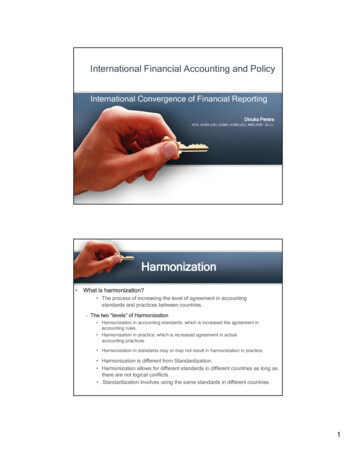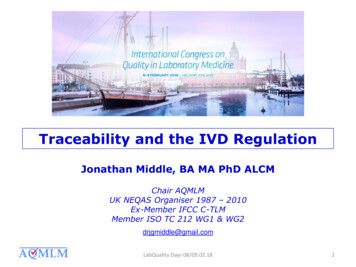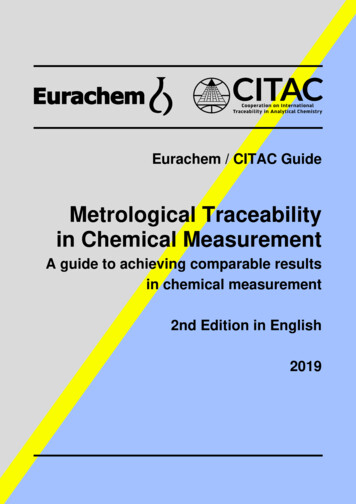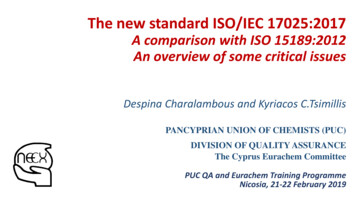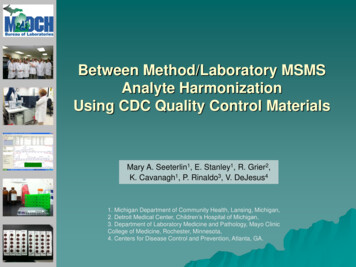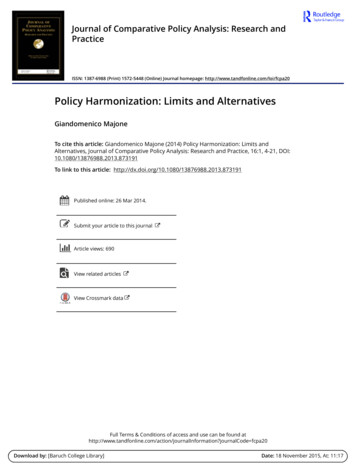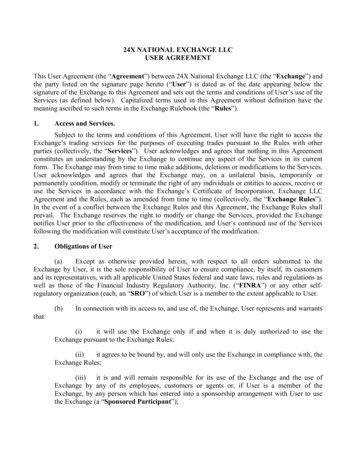
Transcription
www.ridrom.uclm.esAbril - 2015Derecho Romano,Tradición Romanística SN 1989-1970ridrom@uclm.esREVISTA INTERNACIONAL DE DERECHO ROMANOMETROLOGICAL HARMONIZATION AND COMMERCIALEXCHANGE IN THE MEDITERRANEAN AT THE END OF THE2ND CENTURY B.C.: THE ATHENIAN DECREE ON WEIGHTSAND MEASURESMariagrazia RizziUniversità degli Studi di Milano-BicoccaRicercatore Universitariomariagrazia.rizzi@unimib.it271
www.ridrom.uclm.esAbril - 20151. In a series of works aimed at analyzing the economy ofimperial Rome under the lens of a theory that has garneredrecognition as New institutional economics, and which was, inits most important parts co-created by economic historianDouglass C. North1, Elio Lo Cascio notes the potentialimportance of this approach to “permettere una micodell’Impero romano come organizzazione politica unificata neltempo e più specificamente una migliore comprensione deifattori che determinano le modificazioni istituzionali e lisulla“performance” dell’economia romana”. Lo Cascio empathizesin particular that “la fine delle guerre civili, il successivoemergere di un regime politico stabile e l’unificazione delmondo Mediterraneo permisero la creazione di uno scenarioistituzionale che poteva rendere gli scambi più facili e sicuriportando con sé una forte riduzione dei costi di transazione. Lostabilimento di condizioni più pacifiche e sicure sul mare (già1 D.C. NORTH, Institutions, Institutional Change and Economic Performance,Cambridge, 1990. It is virtually impossible to give an exhaustivepanorama of the vast amount of literature that has been triggered byNorth's work. For an overview, see E’. BROUSSEAU - J.-M. GLACHANT (eds.),New institutional economics, Cambridge, 2008; E.G. FURUBOTN - R. RICHTER,Institutions and economic theory. The contribution of the New InstitutionalEconomics, 2nd ed., Ann Arbor 2005; I. PIES – M. LESCHKE (eds.), DouglassNorths ökonomische Theorie der Geschichte, Tübingen, 2009, all with extensivebibliographical notes.272
www.ridrom.uclm.esAbril - 2015come risultato della soppressione della pirateria), la diffusionedi una “tecnologia della misurazione” e di sistemi metrologicicomuni, la discussione di regole comuni nell’ambito di ciò chepossiamo definire il diritto commerciale, nonché la diffusionedella nozione romana della proprietà sono tutti fattori chehanno potentemente contribuito alla drastica riduzione dei costidi transazione”2.2 E. LO CASCIO, La “New Institutional Economics” e l’economia imperialeromana, in M. PANI, (ed.), Storia romana e storia moderna, Bari, 2005, p. 78and passim. The theme of the effect of institutions on transaction costs ispicked up repeatedly by this scholar in other contributions, cf. E. LOCASCIO, The Roman Principate: The Impact of the Organization of the Empire onProduction, in E. LO CASCIO - D. RATHBONE (eds.), Production and publicpower in antiquity. Eleventh International Economic History Congress (Milano12-17 Sept. 1994), Milano, 1994, p. 93 ff. ( revised ed. in E. LO CASCIO – D.RATHBONE (eds.), Production and Public Powers in Classical Antiquity,Cambridge, 2000, p. 77 ff.); ID., Il denarius e gli scambi intermediterranei, in G.URSO (ed.), Moneta Mercanti Banchieri. I precedenti greci e romani dell’Euro.Atti del convegno internazionale, Cividale del Friuli, 26-28 settembre 2002, Pisa,2003, p. 147 ff. ( ID. Crescita e declino. Studi di storia dell’economia romana,Roma, 2009, p. 195 ff.); ID., Mercato libero e “commercio amministrato” in etàtardo antica, in C. ZACCAGNINI (ed.), Mercanti e politica nel mondo antico,Roma, 2003, p. 307 ff. ( ID. Crescita e declino. Studi di storia dell’economiaromana. Roma, 2009, p. 273 ff.); ID., The role of the state in the Roma economy making use of the “New Institutions Economics”, in P.F. BANG - M. IKEGUCHI –H. ZICHE (eds.), Ancient Economies, Modern Methodologies: Archeology,Comparative History, Models and Institutions. Bari, 2006, p. 215 ff.; ID. Impero,città e relazioni commerciali nel Mediterraneo romano, in R. BEN-GHIAT (ed.),Gli imperi. Dall’antichità all’età contemporanea, Bologna, 2009, p. 73 ff.; ID.273
www.ridrom.uclm.esAbril - 2015Particularly interesting seems, among others, the reference to gical systems which, in Lo Cascio's view, would havecontributed to a diminishment of such costs, constituting ingeneral an important kind of intervention which would havemade exchange safer and therefore helped to improve economicoperations significantly. Concerning this matter, Lo Cascio, inanother article, states that "the diffusion of a "technology ofmeasurement" and indeed the spread of common metrologicalsystems, reduced the costs of measuring", citing the fact that"this diffusion of a technology of measurement (for example ofland) and the reduction of measurement costs could also haveaffected the growing diffusion of the notion (and practice) ofprivate property in the more backward areas of the west:"where measurement costs are very high, the good will be acommon property resource"3.Even if such an example might demonstrate the importance ofmetrological aspects for the economy, the role of publicinterventions regarding weights and measures and their impacton transaction costs and the determination of economicCostanti e mutamenti nell’equilibrio economico imperiale, in L. CAPOGROSSICOLOGNESI - E. TASSI SCANDONE (eds.) Vespasiano e l’impero dei Flavi. Atti delConvegno Roma, 18-20 novembre 2009, Roma, 2012, p. 1 ff.3E. LO CASCIO, The Roman Principate, op. cit., p. 95 ( p. 79).274
www.ridrom.uclm.esAbril - 2015performance4 can be read in a more general context, especiallytaking into account the importance of means to quantifyweight, volume and length for the carrying out of commercialtransactions.Transaction costs, according to North "consist of the costs ofmeasuring the valuable attributes of what is being exchangedand the costs of protecting rights and enforcing agreements.These measurement costs and enforcement costs are the sourcesof social, political, and economic institutions"5.Often taken for granted in today's markets, accurate andtransparent knowledge about the weight and volume/length(apart from a simple item count) of a traded good can probablybe considered as the most basic information to assess its“valuable attributes”. Consequently, North emphasizes "the4Quoting once more the words of E. LO CASCIO, La “New InstitutionalEconomics”, op. cit., p. 74.5D.C. NORTH, Institutions, Institutional Change, op. cit., p. 27. On the -often overlooked - differences between this approach and the concept ofsocial cost developed by R.H. COASE, The Nature of the Firm, in Economica, 4(1937), p. 386 ff. and R.H. COASE, The Problem of Social Cost, in Journal of Lawand Economics, 3 (1960), p. 1 ff., cf. G. SCHRÖDER, Approach matters – Dieambivalente Bedeutung von Rationalität und Transaktionskosten in DouglassNorths entwicklungökonomischem Ansatz, in I. PIES - M. LESCHKE (eds.),Douglass Norths ökonomische Theorie, op. cit., p. 44 ff.275
www.ridrom.uclm.esAbril - 2015development of standardized weights and measures"6 and"units of account" among the typical necessities of an ancientsociety in which trade begins to expand beyond a single villageand long-distance commerce, often through lengthy shipvoyages is being established7.This importance can be observed in commercial operations on alocal as well as an inter-regional level and also, of course,between provinces. The various means to combat metrologicalfraud, the existence of authorities appointed to superviseweights and measures and to provide access to officiallygauged instruments, and in particular the presence of sekomataand mensae ponderariae where markets took place, can all beinterpreted in this direction8.6The problem of units by which goods are measured often differingfrom attributes for which those goods really are desired, i.e. the use ofproxy measures which might indicate the desired attributes, but neithernecessarily nor accurately (e.g. the weight of an orange in relation to itsfreshness, ripeness or the amount of juice it will give) does not diminishtheir importance but rather emphasize it. Without the ability to determineweight and/or volume/length accurately, all the problems mentioned byY. BARZEL, Cost and the Organization of Markets, in Journal of Law andEconomics, 25 (1982), p. 42 ff would be even more severe.7D. NORTH, Institutions, op. cit., p.99 f.8For an analysis of these kinds of interventions cf. M. RIZZI, Exiniquitatibus mensurarum et ponderum. Appunti intorno alle frodi metrologichenell’antichità greca e romana, in Ridrom, 11 (2013), p. 288 ff.; EAD., Misurecome attributo del potere. Il ruolo del potere pubblico in materia di pondera e276
www.ridrom.uclm.esAbril - 2015In the context of trade relations between provinces, there aresome specific interventions during the age of roman dominancein the Mediterranean which are especially worthy of attention.2. The central role of an attic decree the end of the secondcentury B.C. (IG II2 1013), which has been cited frequently butrarely analyzed in more depth, has to be recognized in thisregard9.mensurae nell’ambito delle relazioni giuridico-economiche nel mondo greco eromano tra il III secolo a.C. e il III secolo d.C., in AIIN, 59 (2013) [2014], p. 143ff.9 IG II2 1013. Other editions of the decree: CIG I 123; IG II1 476; E.S.ROBERTS – E.A. GARDNER, An introduction to Greek Epigraphy. II. TheInscriptions of Attica, Cambridge 1905, p. 170 ff., n. 64; C. MICHEL, Recueild’inscriptions grecques, Supplément, Hildesheim - New York, 1912 (1976), p.64, n. 1501; O. VIEDEBANTT, O. Der athenische Volksbeschluß über Maß undGewicht, in Hermes, 51 (1916), p. 121 ff.; R.E. WYCHERLEY, The AthenianAgora. III. Literary and Epigraphical Testimonia, Princeton, 1957, p. 182 f.;H.W. PLEKET, Epigraphica. I. Texts on the Economic History of the Greek World,Leiden, 1964, p. 22 ff, n. 14; L. CLINTON, Eleusis. The inscriptions on Stone.Documents of the Sanctuary of the Two Goddesses and Public Documents of theDeme. I, Athens, 2005, p. 261 ff., n. 237. M.M. AUSTIN, The Hellenistic Worldfrom Alexander to the Roman Conquest. A selection of ancient sources intranslation, 2nd ed., Cambridge, 2006, p. 238 ff., n. 129. Specific studiesdedicated to this source are scarce. Only two such works have beenpublished as of now, cited above article by O. VIEDEBANTT, Der athenische277
www.ridrom.uclm.esAbril - 2015This document contains interesting elements under variousviewpoints: First of all, this text defines a series of sanctionsagainst those who use incorrect measuring instruments and, inVolksbeschluß, op. cit., p. 120 ff. and another by L. BREGLIA PULCI DORIA, Perla storia di Atene alla fine del II sec. a.C. Il decreto sui pesi e misure: IG II 2 1013,in MEFRA, 97 (1985), p. 411 ff. Among those contributions which examinethe decree more or less closely, a series of works on economic history haveto be cited. Amid the most recent contributions cf. C. KOCH,Reformbemühungen um Münzwesen und Währungssysteme in Griechenland,BIDR, 103-104 (2000-2001) [2009], p. 247 ff.; J. FOURNIER, Entre tutelleromaine et autonomie civique. L’administration judiciaire dans les provinceshellénophones de l’Empire romain (129 av. J.-C. – 235 apr. J.-C.), Athènes, 2010,in particular p. 121 f., p. 150 f.; C. DOYEN, Études de métrologie grecque. II.Étalons de l’argent et du bronze en Grèce hellénistique. Louvain-la-Neuve,2012, p. 148 ff. U. FANTASIA, I magistrati dell’agora nelle città greche in etàclassica ed ellenistica, in C. AMPOLO, (ed.), Agora greca e agorai di Sicilia, Pisa,2012, p. 31; C. HASENOHR, Athènes et le commerce délien: lieux d’échange etmagistrats des marchés à Délos pendant la seconde domination athénienne (16788 a.C.), in K. KONUK (ed.), Stephanèphoros. De l’économie antique à l’AsieMineure. Hommages à R. Descat, Bordeaux, 2012, p. 106 f.; C. HASENOHR,Ariarathès, épimélète de l’emporion et les magasins du Front de mer à Délos, inV. CHANKOWSKI – P. KARVONIS (eds.), Tout vendre, tout acheter. Structures etéquipements des marchés antiques. Actes du colloque d’Athènes, 16-19 juin 2009,Bordeaux - Athènes, 2012, p. 260; G. OLIVER, The agoranomoi at Athens, on L.CAPDETREY - C. HASENOHR (eds.), Agoranomes et édiles: institutions desmarchés antiques, Paris, 2012, p. 85 ff.; E.M. HARRIS, The Rule of Law inAction in Democratic Athens, Oxford, 2013, p. 31 f.; M. RIZZI, Per un riesamedelle prime linee del decreto attico sui pesi e misure, in DIKE 17 (2014),forthcoming.278
www.ridrom.uclm.esAbril - 2015general, instruments not conforming to the requirements of thedecree10, as well as against those who alter sample weights andmeasures which were kept in places defined by the decree11.However, even more significant for our discussion are someother provisions of the decree, in particular those in § 3 (l. 1829) and 4 (l. 29-37)12.In § 3 of the inscription it is ordered that only a measure ofthree half choinikes must be used for comestible goods which arespecifically listed, among others Persian nuts, almonds,hazelnuts of Heraclea, pine-nuts, chestnuts, Egyptian beans,lupines, olives and similar goods. The decree also containsdetailed instructions on how this measure had to be built: fivefingers deep with a brim one finger wide as it had to be filledheaped. If any measure smaller than that was used selling thelisted goods, the magistrate had to sell the contents at auction,destroy the measure and deposit the proceeds at the publicbank13.10IG II2 1013, l. 1-7.11IG II2 1013, l. 56-60.12We owe the division of the decree into paragraphs to the first editors.Cf. supra fn. 9. The two paragraphs in question have been entitled Demensura fructuum delicatorum and De pondere mercatoris.13 IG II2 1013 l. 18-29: Those who sell Persian nuts (walnuts), driedalmonds, hazelnuts of Heraclea, pine-nuts, chestnuts, Egyptian beans,dates and any other dried fruits that are sold with a measure of a capacityof three half choinikes of grain leveled off, selling them with this choinix279
www.ridrom.uclm.esAbril - 2015As noted by Breglia Pulci Doria14, among the goods mentionedwe find commonly used products, as well as rarer, moresporadically consumed ones. Furthermore, the list containsboth goods of local origin and imported ones. This fact is ofparticular importance as it indicates that the decree apparentlyapplied to any good for sale independently of its origin,whether locally produced, imported or destined for export.Equally significant is that the choinix defined by the decreecorresponds to two roman sextarii.15 The relevance of thiscorrelation, which was first noted by Viedebantt, is a furtherindication of the intention to simplify and facilitate theheaped up, with a depth of five fingers and a width at the rim of onefinger; similarly those who sell fresh almonds, [newly] picked [olives] anddried figs must sell them with a choinix heaped full, twice the size of thepreviously [mentioned one, with a] rim three half fingers (wide), and theymust use measures choinikes) made of wood; if [anyone] sells freshalmonds, newly picked olives or dried figs [in another way?] or withanother type of measure [he must not sell less] than a medimnus of grain;if he [sells] in a smaller type of measure, the magistrate under whose[supervision he is] in a shall immediately sell [the] contents by auction,pay the price to the [public bank] and destroy the measure (translation byAustin).14 L. BREGLIA PULCI DORIA, Per la storia di Atene, op. cit., p. 417 ff.15The decree introduces this new 1:2 relation between greek androman units also for weights as we will see below immediately.280
www.ridrom.uclm.esmetrologicalAbril - n16.3. But of perhaps even greater importance is the provision in § 4which contains a reform of the commonly used market weight,the mna emporike, ordering it to be incremented from 138 to 150drachmas17 . This resulted in the new mina correspondingapproximately to two roman pounds of ca. 327,5 g18 each.16A measure perfectly in line with the requirements of the decree has beenexcavated in the athenian Agora; for a detailed analysis cf. M. CROSBY, AnAthenian Fruit Measure, in Hesperia, 18 (1949), p. 108 ff.17 IG II2 1013. ll. 29-37: The commercial mina shall weigh 138 [drachmas ofwreath-bearing (silver) according to the weights at the mint and a make[weight] of twelve drachmas of wreath-bearing (silver), and everybodyshall sell all other goods with this mina except for those expresslyspecified to be sold according to the silver coin standard, and they shallplace the beam of the scales level at a weight of 150 drachmas of [wreath]bearing (silver); [the] commercial weight of five minas shall have a [make]weight of one commercial mina, so that when the beam of the scales islevel it shall weigh six commercial minas; the commercial talent [shallhave] a make-weight of five commercial [minas], so that when the beam ofthe scales is level it shall weigh one commercial [talent and] fivecommercial minas; they must all correspond to the [measures] and[weights] in the mint (translation by Austin).18 One mina of 150 drachmas in fact is 654,9 g which corresponds to tworoman pounds at 327,45 g. On this, cf. for all F. HUTSCH, Griechische und281
www.ridrom.uclm.esAbril - 2015Furthermore, the commercial talent was increased fivecommercial minas19, i.e. approximately 9,4%. It has alreadybeen recognized that one of the results of the decree was aneasier conversion among athenian and roman units20, buthardly acknowledged how much compatibility was probablyachieved in practice. To better understand the importance ofthis reform, we will have to take a closer look at the units ofweight used in Athens and Rome. The former used the mina,the latter the (roman) pound. Furthermore, both had an unit forconsiderable amounts of goods which was called the talent,which however equaled 60 minas in Athens, but 100 pounds inRome. In Athens, a duodecimal notation was used, in Rome, atleast in the range from pound to talent, a decimal one. On anrömische Metrologie, Weidmann, 1882 (Graz 1971), p. 155 ff.; K. HITZL, DieGewichte griechischer Zeit aus Olympia, Berlin-New York, 1996, p. 12. Indepth research has been conducted on the changes in weight andmonetary units from Solon up until the enactment of the decree. For anoverview of the debate, see L. BREGLIA PULCI DORIA, Per la storia di Atene,op. cit., in particular p. 420 ff.19 There is also a rather problematic provision regarding the commercialweight of five minas, which poses interpretational difficulties (probablyworth a dedicated contribution of its own) which cannot be analyzed inmore depth here. For an overview O. VIEDEBANTT, Der athenischeVolksbeschluß, op. cit., p. 138.20Cf. O. VIEDEBANTT, Der athenische Volksbeschluß, op. cit., p. 137 ff., whothen was followed in this by most of the subsequent authors occupyingthemselves with the decree.282
www.ridrom.uclm.esAbril - 2015inter-mediterranean scale, trading large amounts of goodsbased on the former conversion of the athenian talent to theroman with a relation of 1:1,1 (a difference of 10%) should nothave been too problematic for the businessmen experienced insuch trades. Still, the new relation based on the new mina (andslightly rounded up) was more consistent at 1:1,2 reflecting thetwo systems - duodecimal as opposed to decimal - moreprecisely. But the convertibility of the smaller units, mina andlibra was much less convenient before the reform with a relationof 1:1,84 and obviously became much easier at 1:2. However,the § 4 of the decree had an even more interesting andconvenient effect, since after the reform, a roman talent was tobe understood easily as equaling 50 athenian minas and anathenian talent as 120 roman pound. Thus, a simple and elegantway of interoperability between the duodecimal greek and thedecimal roman notation of weight was achieved on all levels among big units, among small units and even between big andsmall units of both systems, back and forth.So if on one hand we can identify the combating of fraud as anaim of the decree, and the provisions in §§ 3 and 4 ascontributing to that goal by reducing uncertainties regardingthe amount of traded goods, it also seems plausible that ithelped to improve economic performance throughout theMediterranean by facilitating commerce on a geographically(among territories who used either the greek or the romansystem), personally (more people were able to participate in283
www.ridrom.uclm.esAbril - 2015commercial activities) and quantitatively (more goods beingtraded) larger scale. Indeed, during the era in which the atticdecree on weights and measures was enacted, Rome's influencethroughout the Mediterranean was constantly increasing. Theuse of units easily convertible to those used by Romans, like thenew mna emporike is not only likely to have enabled more tradebetween Rome and Athens themselves, but also amongcommunities familiar with either one of those systems, thereby"closing a gap" not only among two important cities of thetimes, but also between territories familiar with either of thetwo unit systems21.4. The possible reasons and political intentions leading to thedecree are a somewhat controversial subject among somescholars. In particular the question is raised if the reforms of thedecree were due to an initiative by Athens itself or ratherinducted by roman pressure and, in relation to that, if there wasthe intention to further the relationship among Athens andRome for the benefit of the latter or if the decree was mainly a21For other possible examples of metrological harmonization cf. M. RIZZI,Le misure come attributo del potere, op. cit., 169 ff.284
www.ridrom.uclm.esAbril - 2015defensive measure by the former to defend itself against thefraudulent practice of roman merchants22.The considerations above regarding the levels of compatibilityachieved by the decree and their potential effects on inter22As one of the few scholars to examine the decree more closely, O.VIEDEBANTT, Der athenische Volksbeschluß, op. cit., p. 141 ff. dedicatedgreater attention to these aspects, emphasizing in particular the de factopolitical dependency of Athens which, although formally a free alley ofRome, found itself increasingly dominated by the latter. Furthermore henoted the influence of roman merchants, mainly interested in their ownprofit, on roman politics. On the other hand, he also presents a series ofarguments that could be made in the opposite direction, i.e. that thereform was adopted by Athens voluntarily and perhaps even at thepossible disfavor of Romans. If it was indeed Romans that had pressed forthe decree, he notes, it would have given Athenians powerful instrumentsto control weights and measures used by Romans. He also takes intoaccount the hypothesis by B. KEIL, Zur Victoriatusrechnung auf griechischenInschriften, in ZfN, 32 (1914-20), p. 46 ff. regardingthe decree of theDelphic Amphictyony CID IV 127 ll. 2-3 quite probably datable betweenthe end of the second and the beginning of the first century B.C. whichordered the acceptance of the attic tetradrachm in exchange for fourdrachmas of silver as compulsory in the whole territory of Amphictyony.Based on this decree, the use of the tetradrachm as an "international"currency, already in widespread use, was ordered. According to Keil, thiswas done to protect Athenian assets and Viedebantt asks, if the decree onweights and measures might be based on similar motives. The comparisonof the two decrees is resumed by L. BREGLIA PULCI DORIA, Per la storia diAtene, op. cit., p. 426 ff. and, more recently among others by J.D. SOISIN,Alexanders and Stephanephoroi at Delphi, in CP, 99 (2004), p. 201 ff.285
www.ridrom.uclm.esAbril - 2015mediterranean trade might however indicate an equallyconceivable third option. Maybe the new regulation was notthat disadvantageous for any one party at all, but rather asound business proposal all participants profited from23?On a similar note, it would also seem imaginable that theenactment of the decree was not necessarily caused by thepressure of one single political force, but more of a "hands on"solution to solve a set of practical problems pragmatically.North mentions in particular that institutionalization24 often23This has also been mentioned by J.D. SOISIN, Alexanders andStephanephoroi at Delphi, op. cit., p. 202, albeit mainly in the context of CIDIV 127.24For details on the notion of institutions in this context see D.C.NORTH, Institutions, in Journal of Economic Perspectives, 5.1 (1991), p. 97 ff.,who opens his insights with the following definition: “Institutions are thehumanly devised constraints that structure political, economic and socialinteractions. They consist of both informal constraints (sanctions, taboos,customs, traditions, and code of conduct), and formal rules (constitutions,laws, property rights). Throughout history, institutions have been devisedby human beings to create order and to reduce uncertainty in exchange.Together with the standard constraints of economics they define thechoice set and therefore determine transaction and production costs andhence the profitability and feasibility of engaging in economic activity.They evolve incrementally, connecting the past with the present and thefuture; history in consequence is largely a story of institutional evolutionin which the historical performance of economies can only be understoodas a part of a sequential story. Institutions provide the incentive structure286
www.ridrom.uclm.esAbril - 2015begins in informal ways which at a certain point might evolveinto mercantile custom and only later get codified by alegislator - especially in the context of an evolving andexpanding economy25. Perhaps some of the methods tocalculate roman and athenian units in a convenient manner hadbeen used already in one way or another by at least somemerchants to conveniently calculate the amount of a freight, tobetter understand the quantity of an offered good in relation tothe units at home or to make business negotiations a little moretransparent for themselves and their respective counterparts.The decree might have codified such practice, perhaps addinguseful modifications and thereby establishing it not only aslegal, but mandatory business practice.This is, of course, mere speculation at this point. North's ownresearch centers around the institutional evolution of earlymodern Europe26, profiting from a much vaster amount ofdocumented sources than any research on antiquity can hope torely on. Despite of this, there has been an increasing number offor an economy; as that structure evolves, it shapes the direction ofeconomic change towards growth, stagnation, or decline”.25 D.C. NORTH, Institutions, Institutional Change, op. cit., p. 89.26D.C. NORTH, Institutions, op. cit., p. 105 ff. Even when analyzingprimitive societies, his observations rely on contemporary examples likethe Suq, cf. p. 103 f.287
www.ridrom.uclm.esAbril - 2015publications27 recently, analyzing aspects of ancient history inrelation to the New institutional economics. Although suchattempts are also criticized, and any research in this directionhas to be conducted cautiously, we should keep in mind thatthe rise, bloom and demise of the roman empire is anopportunity to observe the continuous evolution of aninstitutional apparatus, including its effectiveness as well asfailures.Transaction costs, according to North, are reduced andeconomic performance improved by incrementally establishing27To give just a few examples, cf. W. SCHEIDEL – S. VON REDEN (eds.), TheAncient Economy, Edinburgh, 2002; A. BRESSON, L’économie de la Grèce descités. I. Les structures et la production, Paris, 2007, p. 16 ff.; D.P. KEHOE, Lawand the Rural Economy in the Roman Empire, Ann Arbor, 2007; W. SCHEIDEL I. MORRIS - R. SALLER, The Cambridge Economic History of the Greco-RomanWorld, Cambridge, 2007; C. MÜLLER, Évergétisme et pratiques financières dansles cités de la Grèce hellénistique, in REA, 113.2 (2011), p. 359 ff.; M. SILVER, InDubious Battle: An Economic Analysis of Emperor Hadrian’s Fish and Olive OilLaws, in Roman Legal Tradition, 7 (2011), p. 1 ff.; K. VERBOVEN, Cité etréciprocité: le rôle de croyances culturelles dans l’économie romaine (c. 200 a.C. –c. 250 p.C.), in Annales: Histoire, sciences sociales, 67.4 (2012), p. 913 ff. For acritical view of a – according to this critique, superficial - use of suchcontemporary economic theories in researching phenomena of ancienthistory cf. L. CAPOGROSSI COLOGNESI, Una “new conjectural economichistory”?, in E. CHEVREAU – D. KREMER - A. LAQUERRIÈRE-LACROIX, (eds.),Carmina iuris. Mélanges en l’honneur de M. Humbert, Paris, 2012, p. 57 ff.288
www.ridrom.uclm.esAbril - 2015"institutions and enforcement"28 over a significant period oftime, creating a positive feedback loop of formal and informal,social, political, and economic elements. It is the sustainment ofsuch a process which probably constitutes the most importantaspect for the evolution of a society and its markets29 from arelatively primitive level based primarily on local operationsand personal relations, passing trough growth, specialization,longer and increasingly complex chains of commercial trade toa highly specialized, industrialized, anonymized and globalizedeconomy like the dominant contemporary one.In this perspective, the interventions by public authoritiesregarding weights and measures constitute only a few amongmany, but nevertheless important, pebbles in a complex andarticulate mosaic, which as a whole, reinforced the trust - notnecessarily among the potentially involved parties themselves,but at least regarding the system surrounding them and theirtransactions - which is
Impero, città e relazioni commerciali nel Mediterraneo romano, in R. BEN-GHIAT (ed.), Gli imperi. Dall'antichità all'età contemporanea, Bologna, 2009, p. 73 ff.; . private property in the more backward areas of the west: "where measurement costs are very high, the good will be a common property resource"3. Even if such an example might .

